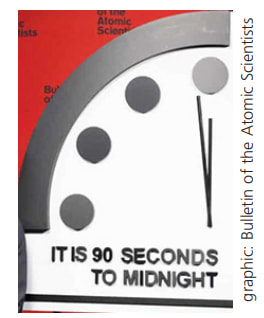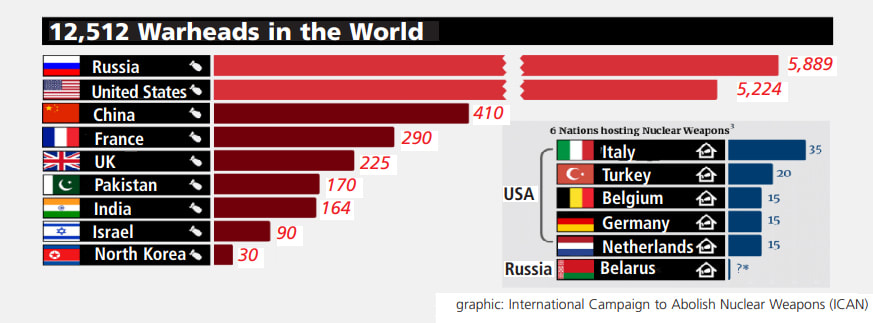
by Nancy Price
The Bulletin of the Atomic Scientists was founded in 1945 by Albert Einstein and the University of Chicago scientists who worked on the Manhattan Project and the bombs dropped on Hiroshima and Nagasaki. Created two years later, the Doomsday Clock symbolically shows how close humanity is to the point of nuclear catastrophe. The clock was originally set at seven minutes to midnight.
On January 24, 2023, the Bulletin of the Atomic Scientists announced they had moved the hands of the Doomsday Clock from 100 to 90 seconds to midnight, the closest it has ever been to zero. This is “largely – though not exclusively – because of the mounting dangers of the war in Ukraine.” The press statement explained the four areas of concern for this new setting: nuclear risk; climate change; biological threats; and disruptive technologies. This was before war broke out in Israel/Palestine, threatening to engulf the Middle East in war. No doubt this will move the Doomsday Clock even closer to zero.
In "The Doomsday Clock Has Never Been So Close to Midnight: What’s on the other side?" Frida Berrigan includes the chronology of seventy-six years of the Doomsday Clock. Frida’s parents, “Elizabeth McAlister and Philip Berrigan, a former nun and priest: refused to pay “war taxes;” trespassed onto military installations to protest our world-ending ways; held vigils at weapons manufacturing plants; and protested during stockholder meetings of giant weapons-making corporations. They also took care of the victims of skewed US policies by organizing soup lines and opening their doors to the unhoused. Frida writes, “by reminding me of where
the hands on the Doomsday Clock stood at any moment, my dad helped me integrate concerns about nuclear weapons into my daily life.”
Time to Ban Nuclear Weapons
Nuclear arsenals are expected to grow over the coming decade, and these weapons are many times more powerful than the bomb dropped on Hiroshima. A single nuclear warhead could kill hundreds of thousands of people with devastating humanitarian and environmental consequences. Today, nine countries possess nuclear weapons: Russia; United States; China; France; the United Kingdom, Pakistan; India, Israel; and North Korea. They have a total of 12,700 nuclear warheads with 9,400 in active military stockpiles. Five other nations host nuclear weapons, and 27 endorse their use.
With the Ukraine-Russian war and threat of widening war in the Middle East, the danger of the tactical use of small nuclear weapons increases the risk they could be used by accident, intention, or miscalculation. Often described as “smaller” or “low-yield” weapons that would cause less damage, these bombs can have yields 20 times that of the one dropped on Hiroshima. See this page on the International Committee to Abolish Nuclear Weapons (ICAN) site for more information.
ICAN, a coalition of non-governmental organizations in one hundred countries, works to stigmatize, prohibit, and eliminate nuclear weapons and supports the ratification of the Treaty on the Prohibition of Nuclear Weapons (TPNW). Their challenge is to build a global movement by getting politicians in the nuclear countries to sign ICAN's Parliamentary — or Legislative — Pledge supporting the TPNW, leading to all nuclear countries ratifying the TPNW.
The US and the other nuclear nations boycotted the TPNW negotiations and refused to sign. Nevertheless, the Treaty opened for signatures on September 20, 2017 and entered into force on January 22, 2022 after the fiftieth ratification. There are currently 93 signatories, 69 states parties and 4 accessed countries.
Nancy Price is co-chair of the Alliance for Democracy.
For a .pdf of this article, click here.


 RSS Feed
RSS Feed
